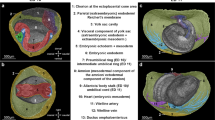Abstract
Aim
The purpose of the present study was to illustrate the modality of rotation of ventral and dorsal pancreatic buds by three-dimensional (3D) reconstructions in the rat embryos, during the Carnegie stages 13–17.
Materials and methods
Serial sections of thirty rat embryos stages 13–17, were observed. The embryos were fixed in Bouin’s solution, dehydrated, and paraffin embedded. The sections, 7 μm thick, were cut in longitudinal or transverse planes and were stained alternately by hematoxylin-eosin or Heindenhain' azan. The images were digitalized by Canon Camera 350 EOS D. The 3D reconstruction was performed by computer using Cell Image Analyser software [2].
Results
The two pancreatic buds ventral and dorsal, were clearly identified at stage 13, in anterior and posterior position, respectively, in relation to the duodenum. In stage 15, the duodenum started its rotation of 90° clockwise. The ventral bud moved 90° from the midline to the right. In stage 16, the ventral pancreas continued its rotation until 180° in posterior position behind the duodenum. In stage 17, the two pancreatic buds were related closely to the ventral part of the portal vein. The two buds began to merge. The anterior face of the pancreas’s head was arising from the dorsal pancreatic bud. The rest of the head including the omental tuberosity and the uncinate process emanated from the ventral pancreatic bud.
Conclusion
The use of 3D reconstruction of the pancreas of rat embryos illustrates the modality of the two pancreatic buds rotation and fusion. This method explains the final position of the pancreas.




Similar content being viewed by others
References
Adda G, Hannoun L, Loygue J (1984) Development of the human pancreas: variations and pathology.A tentative classification. Anat Clin 5:275–283
Baecker V, Travo P (2006) Proceedings of the image. J User and Developer Conference Edition I: 105-110, ISBN: 2–919941-01-1. EAN: 9782919941018
Blechschmidt E (1973) Die pranatalen Organsysteme des Menschen.Hippokrates-Verlag, Stuttgart
Bossy J (1959) A propos de la persistance des deux ébauches pancréatiques chez l’adulte. Arch Anat Histol Embryo 42:110–126
Delmas A (1939) Les ébauches pancréatiques dorsales et ventrales. Leurs rapports dans la constitution du pancréas définitif. Ann Anat Pathol 16:253–266
Gasser RF (1975) Atlas of human embryos. Harper and Row, Hagerstown
Gaubert-Cristol R (1990) Essai d’identification chez le rat des stades embryonnaires humains de la Carnegie: application au cartilage de Meckel. Thèse, Université Montpellier I
Gaubert J, Cristol-Gaubert R, Radi M et al (2009) Contribution to the 3D computer assisted reconstruction of pancreatic buds in the rat embryos. Surg Radiol Anat 31:31–33
Hamilton WJ, Boyd JD, Mossman HW (1976) Human embryology. Prenatal development of form and function, 4ème edn. WJ Hamilton and HWW Mossman, Cambridge
Kanagasuntheram R (1960) Some observation on the development of the human duodenum. J Anat 94:231–240
Lammert E, Cleaver O, Melton D (2003) Role of endothelial cells in early pancreas and liver development. Mech Dev 120:59–64
Odgers P (1930) Some observations on the development of the ventral pancreas in man. J Anat 65:1–7
O’Rahilly R, Muller F (1987) Developmental stages in human embryos. Carnegie Institution, éd Wiley-Liss, Washington
O’Rahilly R, Muller F (1996) Human embryology and teratology. IIéd Wiley-Liss, New York
Orci L, Baetens D, Ravazzola M et al (1976) Ilots à polypeptide pancréatique (pp) et îlots à glucagon: distribution topographique distincte dans le pancréas de rat. C R Hebd Séan Acad Sci Paris 283:1213–1216
Parc R, Soprani A, Louvel A (1977) Hétérotopie pancréatique kystiques de la paroi duodénale sans pancréatite chronique associée. J Chir 114:185–192
Park HW, Chae YM, Shin TS (1992) Morphogenic development of the pancreas in the staged human embryo. Younsei Med J 33(2):104–108
Park S, Bang S, Kim MH et al (2006) Partial agenesis of dorsal pancreas with Castleman’s disease in pancreatic tail area. Korean J Med 71(1):80–85
Philsalix C (1888) Etude d’un embryon humain de 10 millimètres. Arch Zool Exper Gen His Nat Morph Histol Evol Animaux 2(6):2
Slack JM (1995) Developmental biology of the pancreas. Development 121:1569–1580
Streeter GL (1945) Developmental of human embryos: Description of age groups XIII, embryo about 4 or 5 millimetres long, and age group XIV, period of indentation of lens vesicle. Contr Embryol Carnegie Inst 31:27–63
Wind G, Allely E, Jenkins D (1989) Microcomputer reconstruction of pancreaticobiliary embryogenesis. Clin Anat 2:225–233
Woodburne RT, Olsen LL (1951) The arteries of the pancreas. Anat Rec 111:255–270
Conflict of interest
The authors declare that they have no conflict of interest.
Author information
Authors and Affiliations
Corresponding author
Rights and permissions
About this article
Cite this article
Godlewski, G., Gaubert, J., Cristol-Gaubert, R. et al. Moving and fusion of the pancreatic buds in the rat embryos during the embryonic period (carnegie stages 13–17) by a three-dimensional computer-assisted reconstruction. Surg Radiol Anat 33, 659–664 (2011). https://doi.org/10.1007/s00276-011-0800-3
Received:
Accepted:
Published:
Issue Date:
DOI: https://doi.org/10.1007/s00276-011-0800-3




